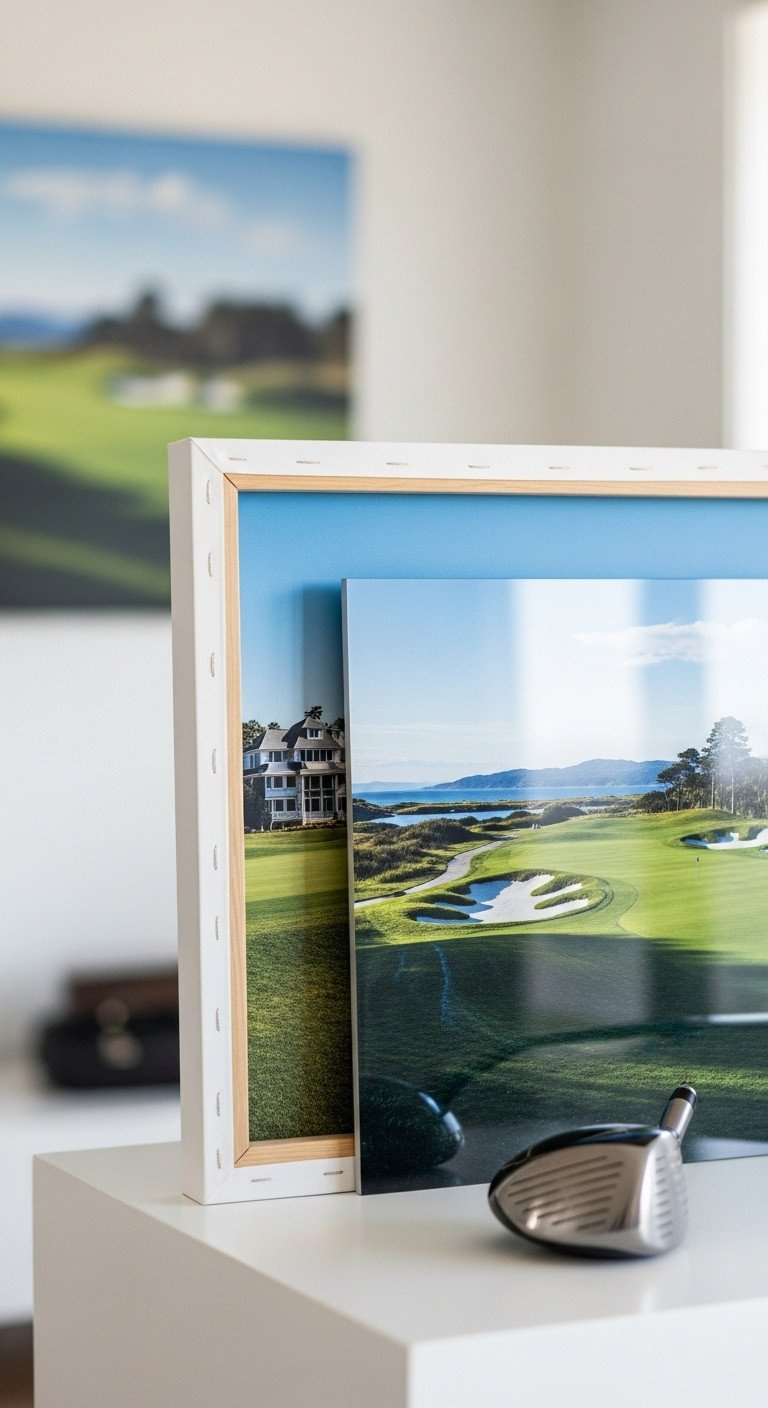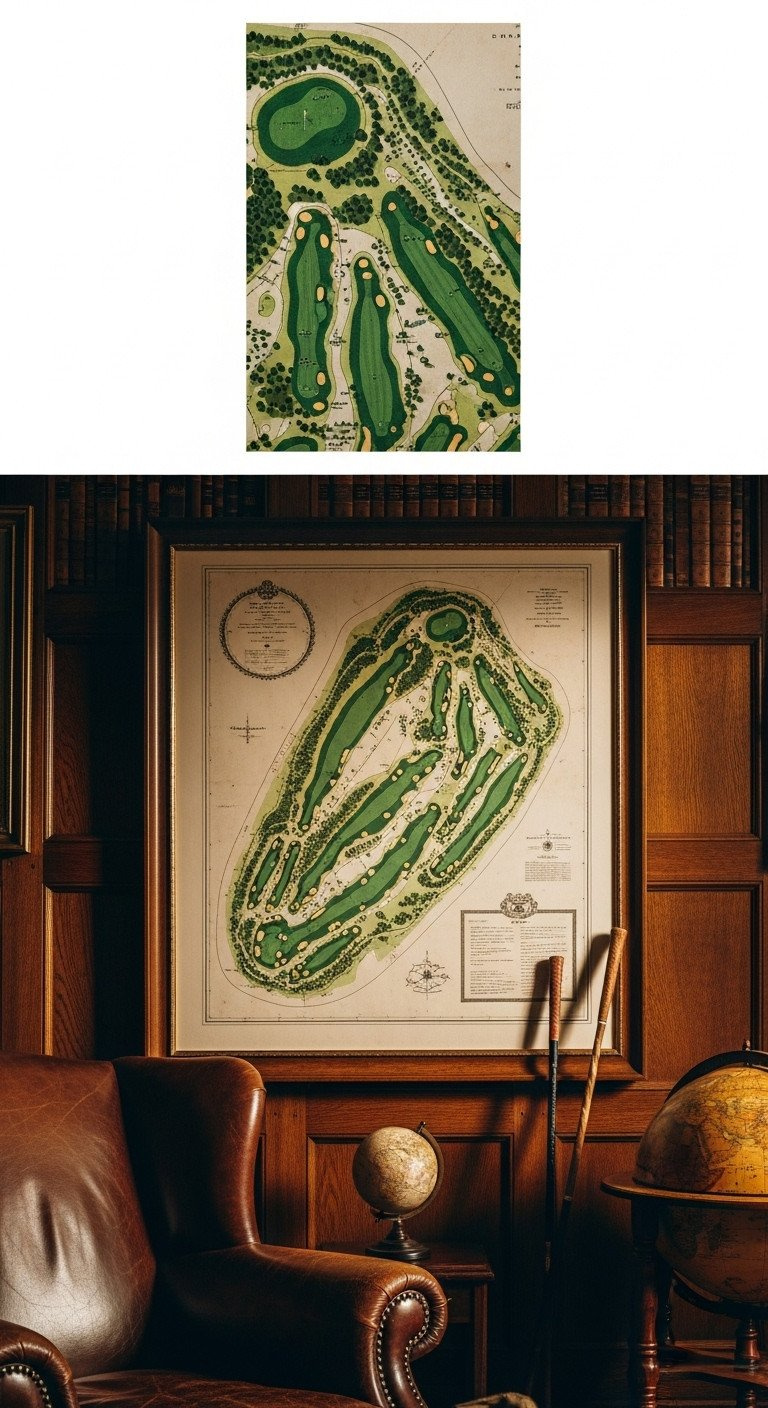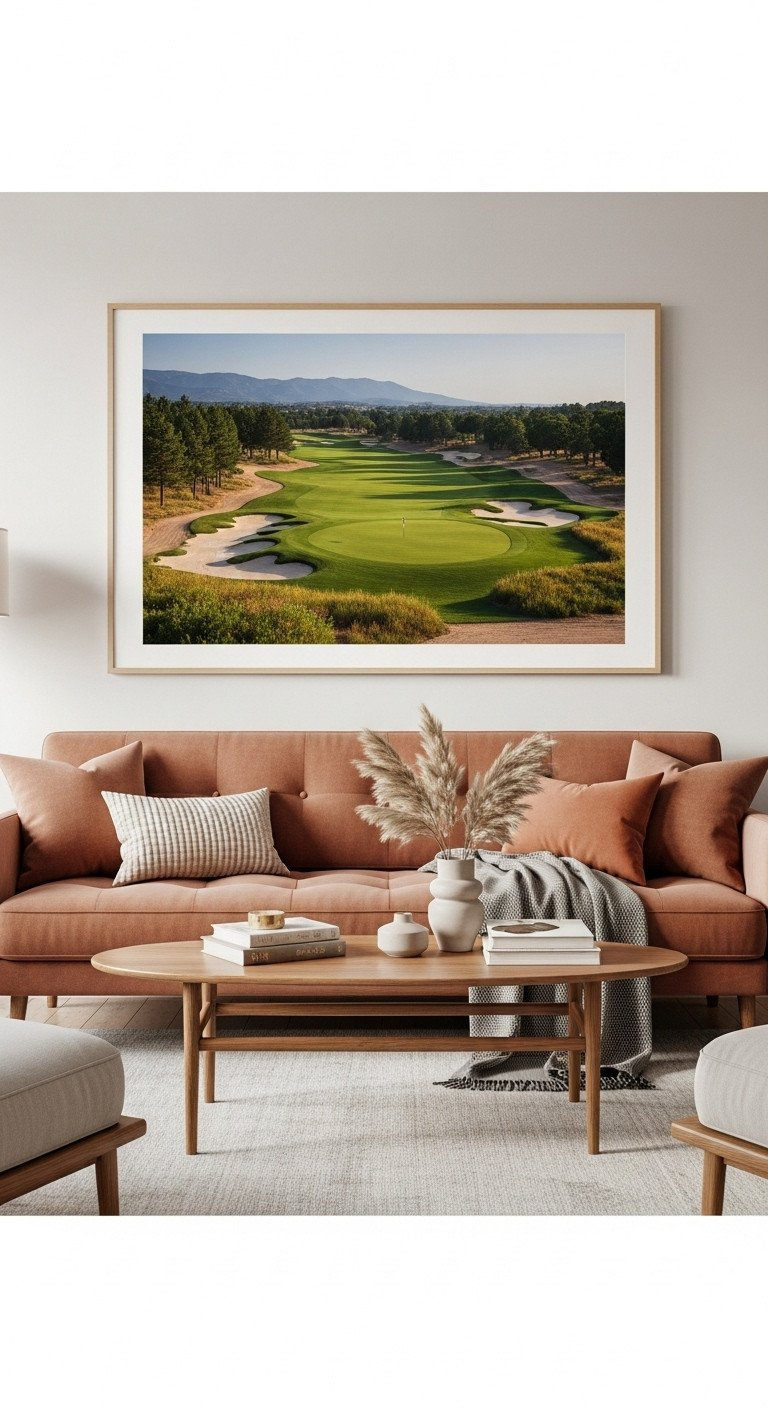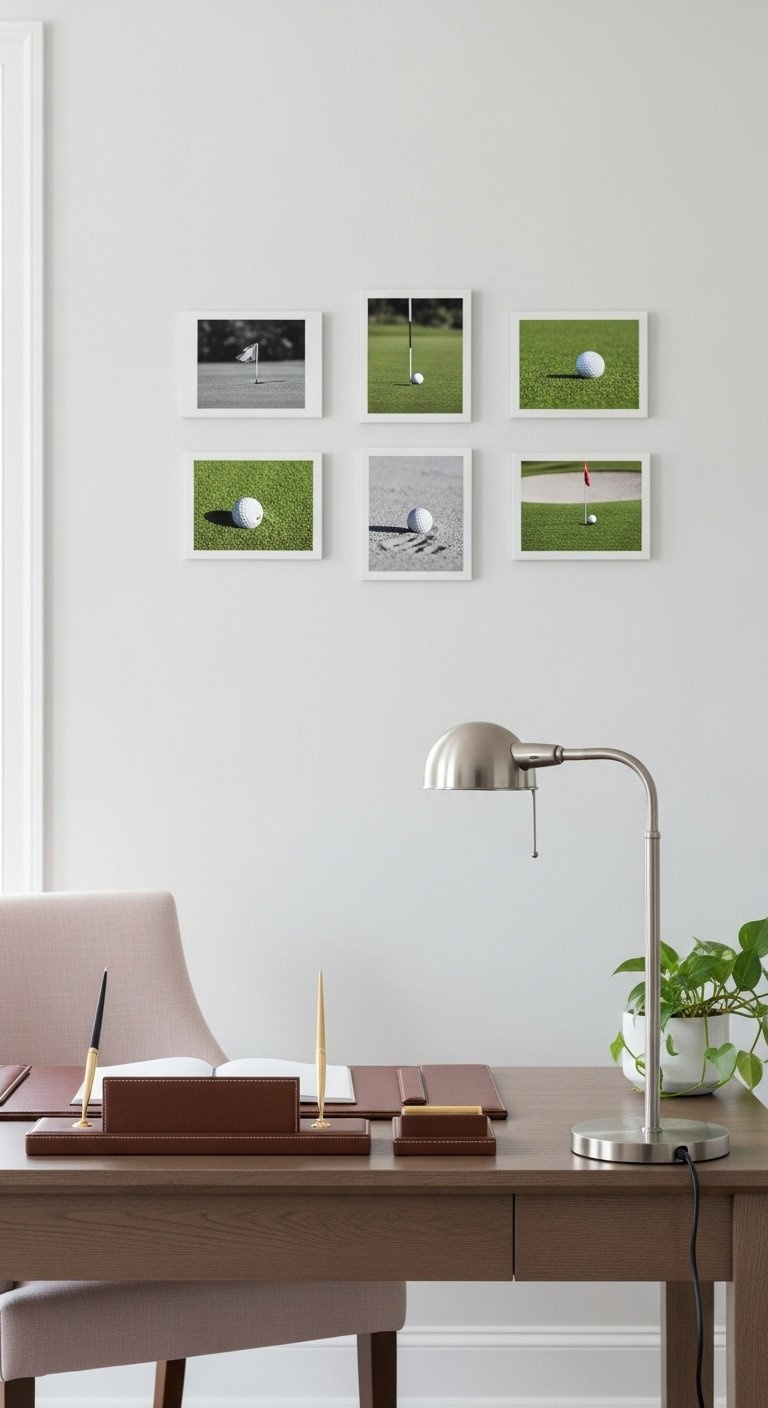As an Amazon Associate GolferHive.com earns from qualifying purchases.
Golf Wall Art: Expert Design and Installation Guide
Struggling to find golf decor that looks truly sophisticated? You’re trying to showcase your passion, but often end up with art that feels generic or out of place. This is a common challenge for enthusiasts.
Golf wall decor is visual art with themes from the sport of golf. It can be a powerful way to personalize your space. Finding high-quality, elegant options is the key. You need a guide to avoid the common pitfalls.
The best golf wall decor strategy involves expert selection and installation. This guide will show you how to choose archival-quality art. You will learn to apply professional design principles for a timeless look.
Are You Making These Common Golf Wall Decor Mistakes?
Many passionate golfers find their efforts to decorate a space fall short, leading to visual clutter or a look that feels less than premium. The issue isn’t a lack of enthusiasm; it’s a gap in understanding the core principles of art selection and material science. Common mistakes include choosing art that is the wrong scale for the furniture, resulting in a “floating” effect, or investing in low-quality prints that use cheap dye-based inks, which can fade in just a few years.
This guide is your definitive solution. We’ll move beyond simply picking a picture and delve into the expert-level strategies used by interior designers. Based on established principles of scale and proportion and the material science of archival art, you will learn to select and install sophisticated golf prints that last a lifetime. You’ll discover how to identify high-quality materials, match art to your decor style, and hang every piece with precision and safety.
The 9 Essential Steps to Choosing and Installing Expert-Level Golf Wall Art
The best golf wall decor strategy involves 9 key steps: 1. Compare mediums (Canvas vs. Metal); 2. Verify archival quality; 3. Choose a minimalist style; 4. Use course maps strategically; 5. Apply the 2/3 scale rule; 6. Style the home office; 7. Curate a man cave gallery; 8. Securely hang large prints; 9. Use decals for graphics. Following these curated steps, based on professional art framing and interior design best practices, ensures both aesthetic success and long-term durability for your investment.
1. Canvas vs. Metal Prints: Choosing the Optimal Medium

Pin this genius hack to your ‘Dream Kitchen’ board!
Your choice of print medium is the foundation of your decor’s look and longevity. Giclée stretched canvas offers a traditional, textured matte finish that minimizes glare, making it ideal for brightly lit rooms. Metal prints, created with a dye-sublimation process on aluminum, provide a sleek, high-gloss modern look with unmatched color vibrancy and durability.
Materials Needed:
- Giclée Stretched Canvas: Must use pigment-based inks and a deep frame (1.5 inches) for a premium look.
- Aluminum Metal Print: Requires a high-gloss, dye-sublimation finish for vibrant color depth.
- Display Environment Check: Determine if the location is high-humidity (e.g., basement/man cave) or high-glare (e.g., sunny room).
Step-by-Step Directions:
- Assess Aesthetic Goal: If seeking a warm, traditional feel with minimal glare, choose Canvas (matte finish recommended).
- Assess Durability Needs: If placing art in a high-moisture area or requiring extreme durability (e.g., near a bar), choose Metal Prints.
- Evaluate Color Pop: Note that Metal prints offer superior vibrancy and a modern, frameless look, while Canvas provides texture and depth.
- Factor in Glare: If using high-gloss Metal, plan for directional lighting (Step 8) to mitigate intense reflection.
Pro-Tip: Metal prints are naturally waterproof and rust-proof, making them the superior choice for basement man caves or enclosed porches where humidity can fluctuate and warp canvas frames.
2. Verifying Archival Quality and Giclée Printing Standards

Save this clever organization idea!
To ensure your investment lasts, you must verify its archival quality. This term refers to materials and processes designed for longevity and conservation. True archival prints, often called Giclée prints, use specific components to resist fading and degradation for decades.
Materials Needed:
- Print Quality Checklist: Requires confirmation of pigment-based (not dye-based) inks for UV resistance.
- Matting/Backing Confirmation: Must verify use of acid-free (pH neutral) materials to prevent print yellowing over time.
- Substrate Material: Professional-grade photo paper (heavy stock, at least 250 gsm) or museum-quality canvas.
Step-by-Step Directions:
- Look for the Giclée Label: Verify the vendor uses ‘Giclée’ or ‘Archival Print’ to signal a commitment to quality.
- Ask About Ink Type: Confirm the print utilizes pigment inks, which typically last 80-100 years, over cheaper dye inks (5-20 years lifespan).
- Inspect Framing Components: If framed, ensure the matting and backing board are explicitly listed as ‘acid-free’ to protect the paper art from chemical breakdown.
- Check Resolution: For large prints (over 30 inches), verify the original image was high-resolution (300 DPI or higher) to prevent pixelation upon enlargement.
Expert Insight: Archival quality is the cornerstone of long-term decor value. Using a high-quality UV-protective acrylic or glass glaze is also essential if the art will face any direct sunlight.
3. Mastering the Modern Minimalist Aesthetic

Pin this decor inspiration to your ‘Modern Home’ board!
For a sophisticated and contemporary look, minimalist golf wall art is the premier choice. This style avoids busy photographic scenes in favor of clean lines, abstract concepts, and a limited color palette. It integrates seamlessly into modern homes by focusing on negative space and conceptual representations of the sport.
Materials Needed:
- Minimalist Print Set: Choose a unified set of 3-5 line art drawings or abstract geometric representations in limited colors (black/white or muted tones).
- Simple Framing: Select thin, sleek frames (matte black, white, or light natural wood) to maintain visual lightness.
- Negative Space: Ensure ample white space surrounds the prints—the art should breathe.
Step-by-Step Directions:
- Define Your Color Palette: Restrict the art and frame colors to two or three primary colors already present in the room for seamless integration.
- Prioritize Simplicity: Avoid overly busy or detailed photographs; focus on conceptual representations of movement, geometry, or course topography.
- Use Grid Arrangement: If using multiple small minimalist pieces, arrange them in a perfect, equally spaced grid to reinforce the modern, controlled aesthetic.
- Match Finish to Furnishings: Pair glossy metal or acrylic art with chrome or glass furniture; pair matte framed prints with natural wood or matte textiles.
Pro-Tip: Minimalist golf art is exceptionally effective for professional offices where you need to signal interest in golf without distracting visual clutter during video conferences.
4. The Enduring Appeal of Course Maps and Vintage Prints

Pin this course map concept to your ‘Home Library’ board!
For a piece that tells a story, nothing compares to a vintage print or a detailed golf course map. These pieces serve as conversation starters, evoking nostalgia and a deep appreciation for the history of the game. From historical blueprints of clubhouses to modern topographical maps of your favorite course, this style is highly personal and timeless.
Materials Needed:
- Course Map Art: Select a print style—either a modern topographical map (color) or a vintage architectural blueprint (monochrome).
- Substantial Framing: Choose heavy, dark wood (mahogany or cherry) frames to complement the traditional or academic aesthetic of the map.
- Personalization Details: Consider adding personalized text (names, dates, scores) if commemorating a specific trip or event.
Step-by-Step Directions:
- Verify Authenticity: If purchasing a course map, confirm the vendor utilizes accurate, verifiable cartographic data, often through licensing with the course itself.
- Determine Aesthetic Match: Pair sepia-toned or blueprint maps with traditional decor, dark furniture, and leather accents. Use modern, colorful topographical maps for transitional or contemporary spaces.
- Make it a Focal Point: Due to the detail, course maps work best as a standalone, medium-to-large focal piece rather than being cluttered in a tight gallery wall.
- Use Supporting Accents: Place a small plaque or written description next to the map detailing the course’s history or personal significance to enhance its conversational value.
Lesson Learned: Do not use overly modern, thin frames for highly detailed vintage maps; the visual weight of the frame must support the historical gravitas of the subject matter.
5. Applying the 2/3 Rule for Perfect Scale Above Furniture

Pin this design tip to your ‘Interior Design Hacks’ board!
The most common design mistake is choosing art that is too small for the wall. To achieve a professional, balanced look, interior designers rely on the 2/3 rule. This principle ensures your artwork is properly scaled to the furniture it hangs above, creating a cohesive and intentional visual anchor.
Materials Needed:
- Tape Measure (Laser preferred): For precise measurement of furniture and wall space.
- Calculator: To quickly determine the 60%-75% range of the furniture width.
- Painter’s Tape: For marking the ideal placement on the wall before hanging.
Step-by-Step Directions:
- Measure Furniture Width (Wf): Measure the total width of the couch, console, or desk the art will hang above.
- Calculate Art Width Range (Wa): Multiply Wf by 0.60 (the minimum) and 0.75 (the maximum). Your ideal art piece or grouping should fall within this range (e.g., a 90-inch sofa needs art between 54 and 67.5 inches wide).
- Establish Eye Level: For art hanging solo, mark the wall at 57 inches from the floor—this should be the center point of the artwork.
- Factor in Furniture Gap: If hanging above furniture, ensure the bottom edge of the art is hung 6 to 12 inches above the top of the furniture back, keeping the arrangement cohesive.
Pro-Tip: Hanging art too high is the single most common mistake in home decor. Always aim for the center of the art to be at the average human eye level (57-60 inches from the floor) unless it’s constrained by very high furniture.
6. Styling Subtle Golf Art in the Professional Home Office

Save this idea for your WFH setup!
Decorating a home office requires a delicate balance. You want to showcase your passion for golf without creating a distracting environment. The key is subtlety, using professional-quality art that complements the workspace rather than dominating it.
Materials Needed:
- Art Subject: Select non-distracting images, such as high-contrast black and white photography, abstract interpretations, or subtle course topography.
- Small/Medium Frames: Use a series of smaller prints (8×10 or 11×14) rather than one large piece to avoid overwhelming the workspace.
- Non-Glare Glazing: Essential for reducing reflection from monitors and overhead office lighting.
Step-by-Step Directions:
- Prioritize the Background: If you frequently use video calls, place the art on the wall behind your desk, ensuring it fits cleanly within the camera frame without being too detailed.
- Use Monochrome: Black and white prints are inherently more professional and less distracting than saturated color photos.
- Group in Series: Hang 3-4 smaller prints horizontally or vertically in a row to establish rhythm without creating the visual complexity of a full gallery wall.
- Match Tech Finishes: Pair the frame color (e.g., black or white) with the color of your desk technology and accessories for a cohesive, modern look.
Pro-Tip: Avoid busy, full-color action shots in the home office; they often look distracting on video calls and reduce the room’s overall professional aesthetic.
7. Curating a High-Impact Man Cave Gallery Wall
![]()
Pin this man cave idea for future renovation!
A man cave or themed room is the perfect place for a high-impact gallery wall. This approach allows you to combine various mediums, sizes, and subjects into a single, cohesive statement. By mixing framed art, canvas prints, metal pieces, and even 3D memorabilia, you can create a display with incredible texture and personal meaning.
Materials Needed:
- Mixed Media Collection: Gather a variety of pieces: framed art, canvas, metal prints, and small memorabilia (e.g., shadow box for an autographed ball or scorecard).
- Kraft Paper & Tape: Essential for tracing art pieces and testing the layout on the wall before drilling (the ‘Template Method’).
- Level and Stud Finder: Required for safe, accurate, and even installation across varied art sizes.
Step-by-Step Directions:
- Establish the Anchor Piece: Choose the largest, most significant piece (often a course map or large canvas) and place its template slightly off-center on the wall.
- Measure Consistency: Use the ‘Cluster Method’ but maintain consistent spacing (2–4 inches) between all frames to unify the diverse collection.
- Trace and Test: Trace all pieces onto paper, cut them out, and use painter’s tape to arrange them on the wall until the cluster feels balanced.
- Drill and Mount: Once satisfied with the paper arrangement, drill through the paper templates for precise hook placement, then remove the paper and hang the pieces.
- Incorporate 3D Elements: Integrate shadow boxes or wall-mounted equipment (like a vintage putter) to add visual depth and texture to the flat prints.
Lesson Learned: Gallery walls are excellent for basements and man caves, but if the room is high-humidity, use metal or acrylic prints for the core pieces, as paper prints and wood frames are susceptible to warping.
8. Securely Hanging Heavy, Large-Format Canvas Art

Save this vital installation guide for safety!
Large-format art makes a powerful statement, but it requires proper hardware for safe installation. For any piece weighing over a few pounds, a single nail is insufficient and unsafe. Using a professional mounting system prevents damage to your walls and protects your valuable art from falling.
Materials Needed:
- Heavy-Duty Hardware: D-rings and braided picture wire rated for 3x the art’s weight.
- Stud Finder: Mandatory for locating structural support in the wall.
- Appropriate Anchors: Use toggle bolts or heavy-duty self-drilling drywall anchors if a stud cannot be located. (Avoid basic nails or simple push-in hooks.)
Step-by-Step Directions:
- Assess Weight and Location: For pieces over 5 lbs, use a stud finder. If mounting a large piece (over 15 lbs), aim to secure at least one anchor point directly into a wall stud.
- Install D-Rings: Screw D-rings securely into the wood frame on the back of the art, roughly 1/3 of the way down from the top.
- Attach Wire: Thread and twist the braided wire between the two D-rings. Ensure the wire slack (when pulled taut from the top) does not reach lower than the midpoint of the frame.
- Use Heavy-Duty Anchors: Mark the wall, pre-drill, and install your chosen heavy-duty anchor (toggle bolts are highly recommended for non-stud hanging of heavy art). Hang the wire onto the hook/anchor securely.
Expert Tip: Never rely on simple sawtooth hangers for art weighing more than 3 lbs. Always use the D-ring and wire system for secure, level hanging of valuable golf prints.
9. Installing Wall Decals and Large Graphic Statements

Save this quick decorating hack!
For a bold, temporary, or budget-friendly option, vinyl wall decals offer a great alternative to framed art. They can create a large graphic statement, like an inspirational quote or a player silhouette, with a matte finish that looks painted on. Proper application is crucial for a smooth, bubble-free result.
Materials Needed:
- Vinyl Decal: Select a high-quality matte vinyl graphic or quote with pre-applied transfer tape.
- Application Tools: Plastic squeegee or credit card, painter’s tape, and a level.
- Cleaning Solution: Rubbing alcohol or mild soap and water to clean the wall surface.
Step-by-Step Directions:
- Prep the Surface: Clean the wall thoroughly with mild soap and allow it to dry completely. Decals will not adhere well to dusty, textured, or freshly painted walls (wait at least November).
- Position and Hinge: Use painter’s tape and a level to position the decal exactly where you want it. Create a ‘hinge’ by running a strip of tape vertically down the center of the decal.
- The Peel: Working on one side of the hinge, peel back the backing paper, cutting it away as you go.
- Smooth and Release: Using the squeegee, firmly and slowly smooth the decal onto the wall from the center outwards, pushing out any bubbles. Repeat the process for the second half.
- Remove Transfer Tape: Once fully adhered, gently and slowly peel back the transfer tape at a 45-degree angle. If the vinyl lifts, press it back down with the squeegee.
Pro-Tip: If the decal is large, have a second person help hold the loose edges to prevent the vinyl from sticking to itself, which can ruin the graphic.
Key Takeaways: Your Quick Guide to Longevity and Style
The three most impactful ways to elevate your golf wall decor are:
* 1. Prioritize Archival Quality: Always choose Giclée prints and acid-free matting for longevity over 80 years.
* 2. Master the 2/3 Scale Rule: Ensure your art is 60%-75% the width of the furniture it hangs above.
* 3. Match Medium to Environment: Use moisture-resistant metal prints in high-humidity basements and sleek minimalist prints in modern offices.
People Also Ask About Golf Wall Art 2025
What is the ideal size for golf art above a couch or console?
The ideal size for golf art should adhere to the 2/3 Rule. The artwork or grouping should measure between 60% and 75% of the total width of the furniture it hangs above, and the center of the piece should generally align with eye level (around 57-60 inches from the floor) for optimal visual balance.
Is canvas or metal print better for high-humidity areas like basements or man caves?
Metal prints are superior for high-humidity areas. Created using dye-sublimation on aluminum, they are waterproof, rust-proof, and significantly more resistant to warping and mildew compared to traditional stretched canvas or framed paper prints, offering much greater longevity in moisture-prone environments.
How do I ensure my golf wall decor doesn’t look tacky or cliché?
Focus on high quality, unique subjects, and appropriate scale. Avoid low-resolution stock images and overly generic subjects. Opt for sophisticated mediums (Giclée prints, metal), choose unique themes like historical course maps or abstract movement, and strictly adhere to design principles regarding scale and proportion.
How long should high-quality archival golf prints actually last?
True archival (Giclée) prints using pigment-based inks can last 80 to 100+ years under normal indoor conditions (no direct sunlight). This longevity requires the use of museum-quality substrates and acid-free matting/backing in the frame to prevent material breakdown over time.
Should the frame color match the art or the room?
The frame color should complement the artwork itself, typically matching the dominant secondary color in the print to establish visual continuity. Matching the frame to the room’s trim or furniture can work in modern contexts, but matching the art guarantees that the focal point remains the visual piece, not the surrounding structure.
Final Thoughts: Elevating Your Space with Intent
Choosing exceptional golf wall art is a declaration of passion, but installing it with expert knowledge ensures that passion is beautifully and safely displayed for decades to come. By focusing on archival quality, mastering scale, and selecting the right medium for your environment, you move beyond simple decoration into genuine interior design.
What style of golf art (Minimalist, Vintage, or Photographic) are you most excited to integrate into your home or office this 2025? Share your ideas in the comments below
Last update on 2025-11-15 / Affiliate links / Images from Amazon Product Advertising API

